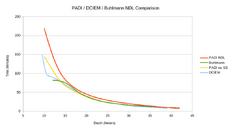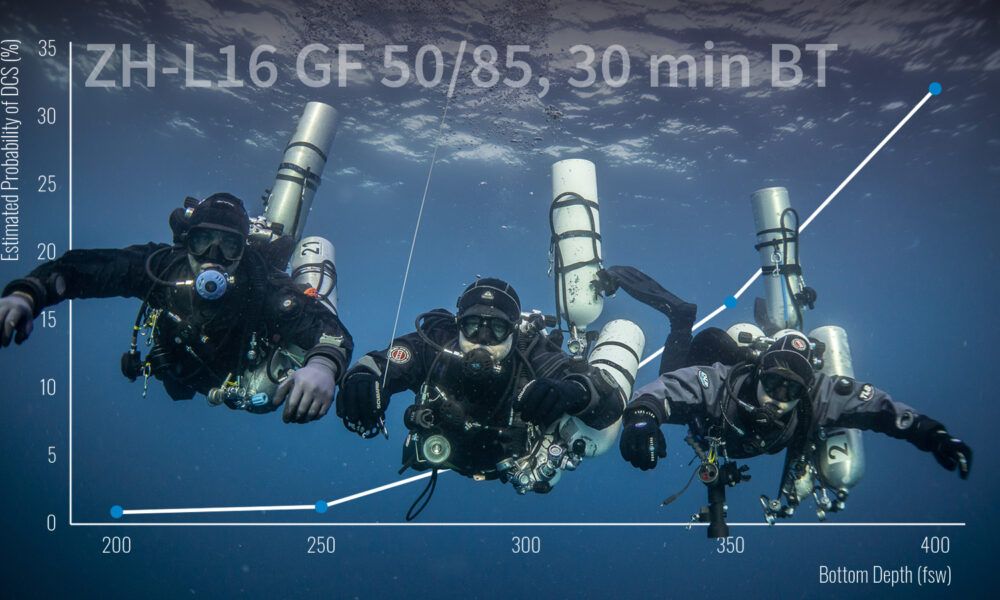VE7DAC
Registered
With Shearwater supporting DCIEM upgrades for commercial and military applications, I thought this might have been discussed here but haven't found much with searches.
I live and dive around Victoria BC, and have done some contract work on the boats that the Canadian Navy Fleet Dive Unit use. (They have some SWEET gas mixing setups, and they all dive Shearwaters BTW. Probably a big part of the reason DCIEM was ported.) I've heard some things about DCIEM tables and how they're more conservative than most recreational algorithms, but I don't see that when I actually look at the tables. I ran a few comparisons in Subsurface, and the DCIEM no-stop and deco tables seem to align quite closely with a 90/90GF, a far cry from the 50/80 I dive, and a lot closer to the US Navy dive tables. It makes sense for a military application, with the bend-em-and-mend-em attitude, but I would have expected a more conservative algorithm for commercial diving, and this is the one they use.
Before a spend a few hours/days of my life in excel comparing various Buhlmann gradient factors and the DCIEM data there an established way to model/evaluate different tables/algorithms? Surely someone has a MATLAB template or something? Maybe a standard set of dives to compare?
I'm specifically interested in seeing what set of gradient factors comes closest to DCIEM. More for education than anything else, but also because CAD$450 is goddamn criminal for a software update/algorithm addition. If I could be doing less deco, safely, with a rigorously tested algorithm developed right around the corner, I would be a very happy diver.
EDIT: Comparing NDLs is pretty simple, I'm doing that now. It doesn't seem too far off from the PADI recommendations, falling somewhere in between the no-stop and "mandatory safety stop" times. Deco comparisons seem trickier to do in a meaningful way.
I live and dive around Victoria BC, and have done some contract work on the boats that the Canadian Navy Fleet Dive Unit use. (They have some SWEET gas mixing setups, and they all dive Shearwaters BTW. Probably a big part of the reason DCIEM was ported.) I've heard some things about DCIEM tables and how they're more conservative than most recreational algorithms, but I don't see that when I actually look at the tables. I ran a few comparisons in Subsurface, and the DCIEM no-stop and deco tables seem to align quite closely with a 90/90GF, a far cry from the 50/80 I dive, and a lot closer to the US Navy dive tables. It makes sense for a military application, with the bend-em-and-mend-em attitude, but I would have expected a more conservative algorithm for commercial diving, and this is the one they use.
Before a spend a few hours/days of my life in excel comparing various Buhlmann gradient factors and the DCIEM data there an established way to model/evaluate different tables/algorithms? Surely someone has a MATLAB template or something? Maybe a standard set of dives to compare?
I'm specifically interested in seeing what set of gradient factors comes closest to DCIEM. More for education than anything else, but also because CAD$450 is goddamn criminal for a software update/algorithm addition. If I could be doing less deco, safely, with a rigorously tested algorithm developed right around the corner, I would be a very happy diver.
EDIT: Comparing NDLs is pretty simple, I'm doing that now. It doesn't seem too far off from the PADI recommendations, falling somewhere in between the no-stop and "mandatory safety stop" times. Deco comparisons seem trickier to do in a meaningful way.






